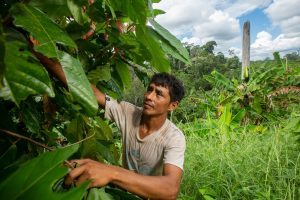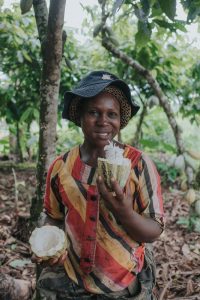Cocoa is in high demand. In 2018, the global chocolate industry was worth close to USD 100 billion, and it is projected to grow. Consumers are increasingly asking for sustainably sourced products, and new kinds of investors are looking for positive environmental and social impacts, in addition to financial returns.
But, many cocoa farmers are poor, even now when the market price for cocoa is relatively high. During the past two years, when prices were lower, farmers had an even harder time making a living. So much so that Ghana and Côte d’Ivoire, the world’s largest cocoa producers, recently demanded that chocolate companies pay a minimum floor price for cocoa, in an attempt to guarantee smallholders a minimum income.
While both countries have agreed to sell their 2020–2021 cocoa crops for no less than USD 2,600 per ton, such an agreement has been deemed to be at best a short-term fix for struggling cocoa producers. Rather, say scientists from the CGIAR Research Program on Forests, Trees and Agroforestry (FTA), the cocoa sector urgently needs to completely rethink its business models. Only then will equitable benefit sharing among all actors in the cocoa value chain be possible.
Challenges abound

Peter Minang, leader of landscape dynamics, productivity and resilience research under FTA, pointed out that many national economies in Africa depend on the production of agroforestry commodities such as cocoa, cashew nuts, shea butter, and coffee, cultivated across millions of hectares of forests and parkland. Cocoa alone covers six million hectares across Ghana, Nigeria, Cameroon and Côte d’Ivoire which, combined, supplied around 75 percent of the world’s cocoa in 2018–2019.
In addition to the persistent poverty of cocoa growers, many other problems still need solving, explained Minang. These include plant diseases, such as the cocoa swollen shoot virus, which are affecting the production on several million hectares. The heavy use of pesticides is not a viable solution, as they harm human health, pollinators and the overall environment. The cocoa sector is also under pressure to eliminate the currently widespread use of child labor in West Africa.
“There’s a bigger problem, economically,” Minang continued. “Even though Ghana, Nigeria, Cameroon and Côte d’Ivoire produce 75 percent of the world’s cocoa, they capture a small portion of the total value of the global chocolate industry.”
Minang said that scientists could help provide the knowledge and support required to transform this industry so that smallholder farmers can take part in the market and benefit from its value.
[Read more: Bitter or sweet trade for Africa’s cocoa farmers?]
Investments needed
Tony Simons, the director general of World Agroforestry (ICRAF), said he wanted to encourage greater engagement with the private sector: “For every one dollar OECD donors spend on overseas development assistance in the tropics, there is a thousand dollars of private capital to be mobilized. So why are we only focused on that one dollar?”
Particularly, the emerging area of impact investment could have the potential to make a difference for cocoa farmers. About USD 500 billion of so-called impact investments are currently available. While most of this money is directed at energy, transport or waste-reduction investments within OECD countries, a growing share of impact investors seem to be taking an interest in funding land and forest initiatives in the Global South.
Dietmar Stoian, lead scientist on value chains, private sector engagement and investments with ICRAF, has conducted a series of interviews with potential impact investors to understand how cocoa farmers in Ghana might benefit from such funds. He found that current investments focus mainly on increasing productivity, while paying less attention to environmental and social issues.
“This is all very incipient, when talking about impact investments in cocoa,” Stoian said. “I think there is potential, but investors need to be conscious of the realities and needs of smallholders, and adjust their investment schemes to these conditions.”
[Read more: Financial products should be adjusted to better meet needs of community forest enterprises]
New business models

In Ghana and Côte d’Ivoire, smallholders dominate more than 90 percent of cocoa production, but they have a weak position in the value chain. Supporting the organization of smallholders into cooperatives and expanding the role of existing ones could improve farmers’ standing, said Stoian.
“One key issue is where value is added,” he explained. “For now, it happens mostly in the importing countries, not in the producing countries. But, we do have examples from Latin America where some cooperatives have become very good at processing cocoa into diverse chocolate products and placing them in domestic markets at favorable prices.”
The Ghanaian cocoa sector might take its inspiration from Bolivia, for example, where the El Ceibo cooperative is marketing organic and Fairtrade-certified cocoa beans, butter and powder to the international market, allowing farmers to capture a higher price. The cooperative has, more importantly, managed to establish its own cocoa-processing plant, and has positioned a broad array of chocolate products in the domestic market, as a gourmet chocolate choice.
Stoian said you might imagine that Kuapa Kokooo – Ghana’s largest cocoa cooperative with around 100,000 members – and other cooperatives in West Africa could create value for their members through a similar approach.
Finally, models that completely bypass financial returns could be very attractive to farmers, while remaining interesting to investors, suggested Stoian. The Livelihoods Carbon Fund, for example, has launched a program in Côte d’Ivoire through which smallholders receive funds for agroforestry systems in return for carbon credits, he said. This allows investors to mitigate their carbon footprint elsewhere, and, according to Stoian, similar schemes are being considered by impact investors in Ghana.
[Read more: If cocoa prices have fallen, why isn’t your chocolate bar cheaper?]
The role of public policy
While impact investments have potential for smallholders, public policy might play an even greater role. To understand how Ghana is in a position to impose a minimum floor price for cocoa, one needs to know that that the farm-gate price for cocoa produced in Ghana is determined by a committee involving state-led regulators.
“The terms under which companies engage smallholders in Ghana are completely dictated by the Ghana Cocoa Board (COCOBOD), ” commented George Schoneveld, a senior scientist working on value chains, finance and investments for the Center for International Forestry Research (CIFOR). “Change therefore starts with public policy.”
Schoneveld pointed out that COCOBOD is currently partnering with development organizations to solve important challenges, such as replacing old and disease-ridden cocoa stands with improved varieties. “They provide the planting material, replanting support and even compensation payments to enable smallholders to absorb the loss of income associated with replanting,” he said.
However, the COCOBOD-led program’s adoption rates remain low due to tenure insecurity, land scarcity, cultural barriers and other factors. This, according to Schoneveld, highlights the need to build strategic partnerships for more integrated planning and funding approaches, such as is being planned for a large landscape program on cocoa to be led by CIFOR.
Whether the answer to smallholders’ struggles is impact investment, public policy, development programs – or perhaps a combination – remains an open question. Until determined, cocoa farmers will continue to underpin the global chocolate industry, receiving not much more than a bitter aftertaste in return.
##
Some of the discussions on possible directions for a more equitable cocoa sector referenced above took place during the 4th World Congress on Agroforestry in May 2019. Research on the topic is continuing throughout FTA’s program activities.
By Marianne Gadeberg, communications specialist.
FTA is the world’s largest research for development program to enhance the role of forests, trees and agroforestry in sustainable development and food security and to address climate change. CIFOR leads FTA in partnership with Bioversity International, CATIE, CIRAD, INBAR, ICRAF and TBI. FTA’s work is supported by the CGIAR Trust Fund.











